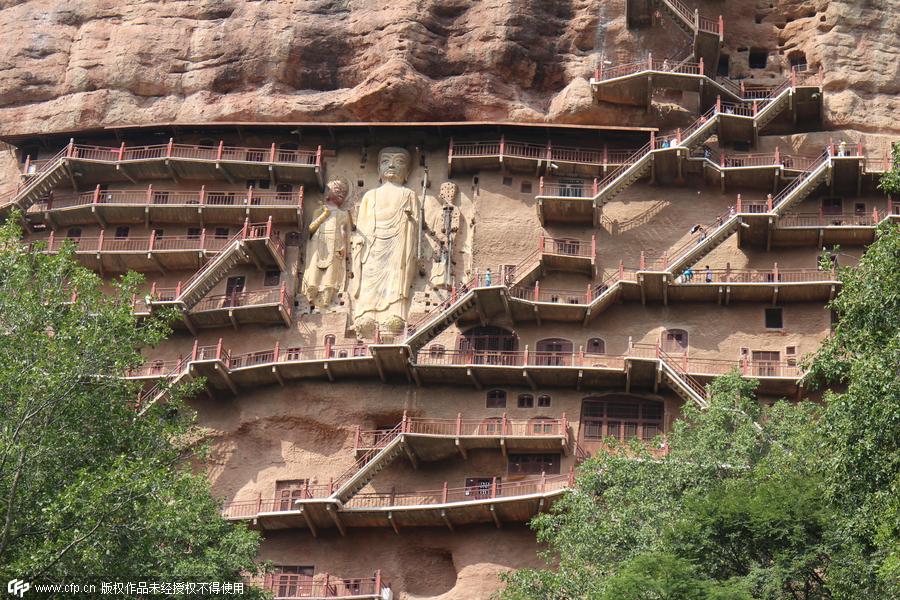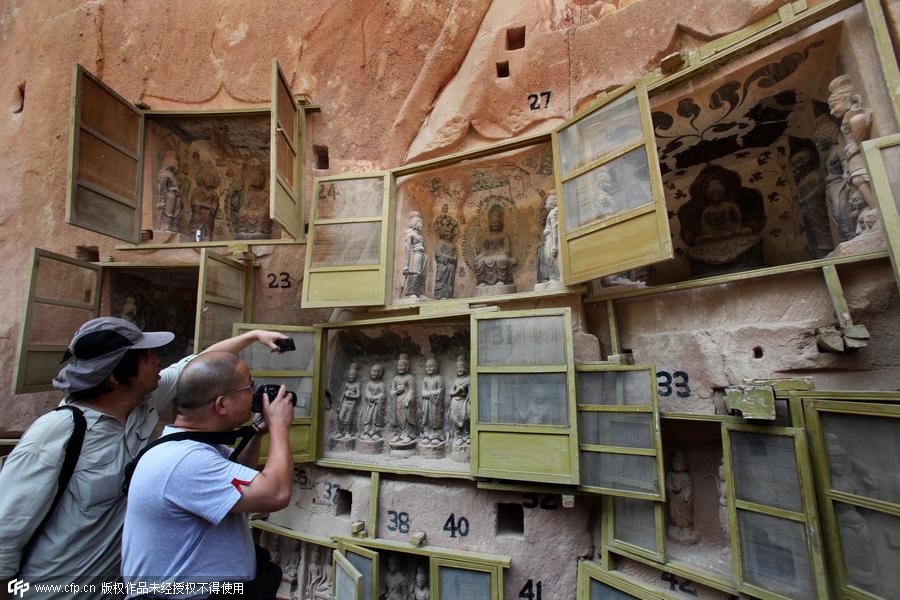The Silk Road or Silk Route is an ancient network of trade and cultural transmission routes that were central to cultural interaction through regions of the Asian continent connecting the West and East by merchants, pilgrims, monks, soldiers, nomads, and urban dwellers from China and India to the Mediterranean Sea during various periods of time.
Extending 4,000 miles (6,437 kilometres), the Silk Road derives its name from the lucrative trade in Chinese silk carried out along its length, beginning during the Han dynasty (206 BC – 220 AD). The Central Asian sections of the trade routes were expanded around 114 BC by the Han dynasty, largely through the missions and explorations of Chinese imperial envoy, Zhang Qian. The Chinese took great interest in the safety of their trade products and extended the Great Wall of China to ensure the protection of the trade route.
Trade on the Silk Road was a significant factor in the development of the civilizations of China, the Indian subcontinent, Persia, Europe, the Horn of Africa and Arabia, opening long-distance, political and economic relations between the civilizations. (Source - wikipedia)
There are 33 historical sites along the millennium-old trade route, with 22 in China's four provincial-level administrative regions (Shaanxi, Henan and Gansu provinces and the Xinjiang Uygur autonomous region) together with eight in Kazakhstan and three in Kyrgyzstan.

The designated portion of the Silk Road passes through China, Kazakhstan and Kyrgyzstan. Source: Institute of Architectural History. China Architecture Design & Research Group.
Here is a list of the 22 historical sites in China.
1. The Site of Luoyang Ancient City, Henan province

In 25 AD, Emperor Guangwu of the Eastern Han Dynasty established his capital in Luoyang and the successive Wei of the Three Kingdoms Period, Eastern Jin and Northern Wei did the same. Thus it had served as a capital for over 330 years until the end of Northern Wei when it was ruined by wars.[Photo/CFP]
2. Dingding gate of ancient Luoyang city of the Sui & Tang Dynasties, Henan province

Dingding gate, the South Gate of the outer city of ancient Luoyang of the Sui & Tang Dynasties. The Dingding Gate is the city gate that has been in use for the longest time among all the ancient capitals in Chinese history. The city was first built in 605 during the Sui Dynasty, as the country's eastern capital.[Photo/CFP]
The famous ancient Silk Road, which served as a corridor for trade and cultural exchanges between Asia and Europe dating back to 2,000 years ago, was given the status of World Heritage in 2014.
Jointly submitted by China, Kazakhstan and Kyrgyzstan, the application for adding part of the millennium-old trade route to the UNESCO list was approved by the World Heritage Committee at a session in the Qatari capital.
3. Site of Hangu Pass, Henan province

The ruins of Hangu Pass are in Xin'an County of Luoyang City, central China's Henan province. It was a strategic pass in ancient China just south of the great eastern bend of the Yellow River in today's Lingbao, Henan province. The Qin Dynasty built the pass in 361 BC as its eastern gate.[Photo/CFP]
The main line of this ancient route connecting the East and the West was in use from the 2nd century BC to the 16th century AD and stretched for more than 8,700 kilometers during its peak.
The complex project includes various types of heritage, including Buddhist sites, military passes and remains of ancient cities.
4. Site of Xiao Han Ancient road, Henan province

Xiao Han ancient road is located in Shanxian county, Henan province. It used to be the traffic hub which linked Chang'an with Luoyang, two ancient Chinese capitals that have rich cultural connotation and high historical value.[Photo/CFP]
5. Giant Wild Goose Pagoda, Shaanxi province

The Giant Wild Goose Pagoda in Xi'an, capital of Northwest China's Shaanxi province,is a masterpiece of China's Buddhist architecture. Originally built in 652 during the reign of Emperor Gaozong of the Tang Dynasty (618 AD- 907 AD), it functioned to house Buddhist sutras that were brought from India by the monk Xuanzang.[Photo/CFP]
6. Small Wild Goose Pagoda, Shaanxi province

The Small Wild Goose Pagoda is located on the central axis of the Jianfu Temple in southern Xi'an. It is one of the two famous and important Buddhist pagodas erected in the Tang Dynasty about 1300 years ago. Jianfu Temple was first built in 684 AD in honor of the second emperor of the Tang Dynasty, Emperor Lizhi (named Gaozong on his accession), on the hundredth day after his death.[Photo/CFP]
7. Site of Weiyang Palace, Shaanxi province

Weiyang Palace was a palace complex, located near the city of Chang'an (modern-day Xi'an) in Shaanxi province. Built in 200 BC,it served as the administrative center and imperial residence of the Western Han Dynasty, as well as the Western Jin dynasty and several other regimes during the Northern and Southern Dynasties.[Photo/CFP]
8. Tomb of Zhang Qian, Shaanxi province

The tomb of Zhang Qian is located in Chenggu County of Hanzhong, Northwest China's Shaanxi province. Zhang Qian (164 BC - 114 BC) was an influential diplomat of China's Western Han Dynasty (202 BC - 9 AD) and one of the pioneers of the ancient Silk Road.[Photo/CFP]
9. Site of Daming Palace, Shaanxi province

Famous for its super-large scale and magnificent buildings, Daming Palace was the main royal palace in the Tang Dynasty (618 AD - 907 AD) where Tang emperors lived and dealt with state affairs.[Photo/CFP]
10. Maijishan Grottoes, Gansu province

The Maijishan Grottoes are a series of 194 caves cut in the side of the hill of Majishan in Tianshui, Gansu province, Northwest China. Inside the caves are clay statues and murals. Construction of Maijishan Grottoes began in 384 AD, the first year of Late Qin era (384 AD- 417 AD), while the following 1600 years saw its continual expansion and renovation.[Photo/CFP]Â
11. Bingling Temple Grottoes, Gansu province

The Bingling Temple Grottoes in Northwest China's Gansu provinceare filled with Buddhist statues, stupas and murals and were a work in progress between the 4th and 10th centuries. The first grotto was begun around 420 AD at the end of the Western Jin Dynasty.[Photo/CFP]
12. Xuanquanzhi Ruins, Gansu province

Xuanquanzhi Ruins is located at an important pass of the Silk Road in Northwest China's Gansu province. It was a relay station. Ruins of beacon towers built over more than 1,000 years can still be found near the Xuanquanzhi Ruins today.[Photo/CFP]
13. Suoyang City Ruins, Gansu province

Suoyang City Ruins is located in Guazhou County, Northwest China's Gansu province. Suoyang, which dates back to the Han Dynasty (202 BC-220 AD), was an ancient city on the Silk Road, a route that facilitated Eurasia trade and cultural exchanges in ancient times.[Photo/CFP]
14. Yumen Pass, Gansu province

Also known as Jade Gate Pass, it is a pass located west of Dunhuang in today's Gansu povince of China. In ancient times, this was a pass through which the Silk Road passed, and was the one road connecting Central Asia and China. Together with Yangguan Pass, Yumen Pass is one of the two important passes on the western frontier of the Han Dynasty.[Photo/CFP]
15. Ancient City of Gaochang, Xinjiang Uygur Autonomous region

It is located at the foot of the Flaming Mountain, about 46 kilometers southeast of Turpan. The ancient city of Gaochang, and the ancient city of Jiaohe, are the best-preserved ruins of the ancient cities in China. The city was initially built as a garrison town in the first century B.C., called Gaochang Wall, and later renamed Kharakhoja, Kocho or King City. It was a key point along the Silk Road. [Photo/CFP]
16. Ancient City of Jiaohe, Xinjiang Uygur autonomous region

Jiaohe Ancient City stands isolated on a 30-meter-high plateau in the Ya'ernaizi Valley, 10 kilometers east of Turpan. The whole city of Jiaohe Ancient City stretches about 1650 meters from south to north, and 300 meters from east to west. Historical records and excavation reveal evidence of a prosperous ancient trading center and military stronghold from 1,600 years ago. Owing to the arid climate and remote location, Jiaohe remains relatively intact, leaving us a rare example of an earthen castle, the largest, oldest and best-preserved earthen city in the world.[Photo/CFP]
17. Ruins of Yangmacheng, Xinjiang Uygur Autonomous Region.

The site of Yangmacheng is located outside the ruins of Beiting protectorate in Jimusar County, Northwest China's Xinjiang Uygur autonomous region. Beiting, the Protectorate of Tang Dynasty (618 AD-907 AD), was one of the most important cities on the ancient Silk Road.[Photo/CFP]
18. Kirzierduoha Beacon Fire Tower, Xinjiang Uygur Autonomous Region.

The Kirzierduoha Beacon Fire Tower is in Northwest China's Xinjiang Uygur autonomous region. Being the oldest and most effective original telegram, beacon towers are the most important component of the defensive project on the Great Wall. They are built continually to pass military messages. In ancient times, if intruders approached, soldiers on the wall would create smoke in the daytime and light a fire at night to warn their troops.[Photo/CFP]
19 . Kizil Thousand-Buddha Caves,Xinjiang Uygur Autonomous Region.

The Kizil Thousand-Buddha Caves sit on the cliffs on the northern bank of the Muzat River, 7 kilometers southeast of Kizil town, Xinjiang Uygur autonomous region.Cut in the third century to eighth or ninth century, it is the earliest Buddhist art treasure trove in China, a whole century earlier than the famous Mogao Grottoes. Currently there are 236 coded caves preserved, which are divided into west and inner valley and rear mountain areas extending to over 3 kilometers.[Photo/CFP]
20. Ruins of the Subax Buddhist Temple, Xinjiang Uygur Autonomous Region.

The Subax Buddhist Temple in Kuqa county of Northwest China's Xinjiang Uygur autonomous region was once an influential temple in the ancient Qiuci State.[Photo/CFP]
21. Sanzang Pagoda, Shaanxi province

Sanzang Pagoda in Xi'an, Shaanxi province was erected in 1944. The pagoda houses the remains of the Tang dynasty monk, Xuan Zang, who is famous for his trip to India to bring back Buddhist scriptures.[Photo/CFP]
22. The Great Buddha Temple, Henan province

The Great Buddha Temple in Binxian county, Henan province was built in 629 AD and is famous for its gigantic Amitabha statue and other refined Buddha grottos, which are delicate and majestically sculpted.[Photo/CFP]
Source - China Daily